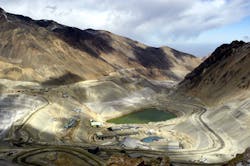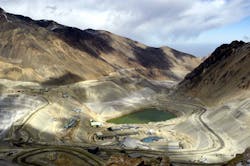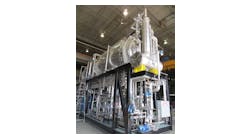Anglo American is one of the world’s largest mining companies, with revenues exceeding $20 billion. A huge consumer of water for its tailings disposal facilities, the company is looking to assess and improve water security across its sites.
By Dr Hubert Fleming
Anglo American is heavily reliant on water as an input to mining and processing activities. As a result, the responsible management of water is critical, given concerns around water security, water quality, rising costs and increasing regulation and scrutiny by authorities. With around 75 percent of our mining operations located in high water-risk regions, we recognise the importance of monitoring our use of and conserving water.
Most of the water is used by our tailings disposal facilities - where we store the non-valuable parts of ore after separating the valuable fraction - and through the control of dust on our haul roads. Consequently, we have made a positive contribution to water security around some operations by leveraging mining infrastructure for community use. The provision of water-related infrastructure that directly benefits communities around our operations is a priority at several of our operations where water scarcity is a prevalent challenge, as well as a key opportunity for development. Such a project is currently under way at our Minas-Rio operation in Brazil.
ICMM and Minas-Rio
The International Council on Mining and Metals (ICMM) has developed a new water stewardship framework, based on adopting a catchment-based approach in 2014. This approach is community-based and engages society to help improve water environments. As a result, the approach requires inclusive engagement and collaboration with all relevant stakeholders on shared water challenges.
In early 2015, the ICMM selected Minas-Rio to collaborate with them in the first application of the guidance, and the project was brought to life in Brazil in 2016. This was an opportunity to assess and improve water security at Minas-Rio. These challenges were compounded by the water crisis Brazil was experiencing. Since 2012, rainfall had been well below average throughout the country as a result of the weather phenomenon known as El Niño.
identifying water risks
The issues regarding a mine’s water-basin management are complex and involve a vast range of aspects - technical, environmental, societal, and reputational. This initiative was an opportunity to run a robust analysis associated with those multi-disciplinary perspectives. Through this process, Anglo American and the ICMM brought together members of the local communities, municipalities, water basin committees and civil society organisations to better understand and manage shared water risks in the San Antonio water catchment.
This enabled us to better understand stakeholder concerns and aspirations related to the use of water in Minas-Rio, identify major water issues and risks in the catchment and across mine life cycle, and, finally, build a response strategy to address water risks. For the ICMM, the pilot allowed them to trial the approach at a water-intense operation and, based on the findings, ensure it was practicably applicable for other members.
Applying the ICMM guidance demonstrated that water-related risks are often seen from very diverse perspectives across Minas-Rio, and that management of such risks can fall under separate systems and processes. The approach has helped Anglo American consolidate these risks so that they can be managed using a holistic framework.
Effectively managing water shortages also mitigates the risk of operational disruptions and presents an opportunity for us to play a leadership role in water catchments. We are seven years into an ambitious 10-year water strategy, focussing on achieving water resilience.
Operational Excellence
To achieve operational excellence, we have set quantifiable water usage goals for every site worldwide, targeting a 14 percent reduction from our projected water consumption by 2020.
In 2016, for the third year in a row, we managed to exceed the 2020 target by achieving an estimated 21 percent water saving against our projected water usage. This saving is predominantly due to projects such as more effective dust suppression, dewatering of tailings and more efficient ore separation - all of which contributed to the approximate water saving of 23 million cubic metres.
Furthermore, water-saving projects across the group saved 23 million cubic metres of water in 2016, while our total new-water consumption decreased by 14 percent from 222 million cubic metres in 2015 to 191 million cubic metres in 2016.
In line with ICMM guidance, we have developed a new water-management standard in partnership with our regional stakeholders, which has a more focused and structured approach to managing catchment-wide water risks. We are working towards more ambitious water savings targets for 2020, which include reducing our absolute freshwater intake by 20 percent and recycling or re-using water for 75 percent of our water requirements.
As well as saving water, we improve efficiency by increasing how much water is recycled and re-used at our sites. For example, production at our Los Bronces copper mine in Chile was constrained by water supply challenges in 2015, which provided an extra impetus to reduce our fresh water consumption. To overcome this particular challenge, we implemented a number of measures including running the recycling system at maximum capacity.
We continued to transport water via a 56-kilometer pipeline from the Las Tortolas tailings dam in Chile to Los Bronces, using a special water-recycling system. Los Bronces now currently recycles more than 78 percent of available water. Overall, this has helped us meet 64 percent of our total operational water requirements with recycled or re-used water - a key milestone as we move towards our long-term goal of 80 percent.
Technology and innovation
Investing in new integrated water solutions is one of our most important technology focus areas and is fundamental to achieving a step-change in water-efficient mining. Over the last seven years this investment has enabled us to introduce several cutting-edge technologies.
Alongside closing the water loop - a ‘sealed system’ approach which aims to drive more efficient water usage through direct water recycle and reuse - these innovations include separating water streams that do not contact wastewater; remote monitoring of water flows and levels in dams and tailings as well as piloting passive water treatment technologies. We are proud of the fact that many best-practice technologies that improve water efficiency are now standard procedures at the majority of our operations.
Having rebuilt our technical team, our FutureSmart Mining™ innovation programme is embracing a host of new and existing technologies. Our sustainability performance, and the way we look at mining’s major challenges overall, will be fundamentally changed by this initiative. It fosters broad collaborative partnerships to find solutions to mining’s most critical challenges in the areas of safety, productivity, energy and water.
We envisage a world in which our mines are integrated and automated, carbon-neutral and water-neutral, low cost and scalable with a reduced and sustainable environmental footprint that contributes positively to local communities.
Our ambition is, where possible, to eliminate fresh water from our mining processes, especially in the separation and transportation of ore and waste (tailings). We are examining how we can reduce the cost of dewatering while looking at the physical and chemical properties of the fine ore particles to understand why they cling so resolutely to water. If successful, we have the potential to significantly limit how much fresh water we draw, while also gaining access to ore bodies in water stressed areas that are critical to supplying the world’s ongoing demand for metals and minerals.
Growing regulatory and social pressure, increasing demands for limited natural resources, climate change and the changing costs of water all highlight the business imperative of achieving water resilience. Our immediate focus is on securing adequate supplies and using resources more efficiently so that we can ultimately reduce our reliance on ‘new’ water to near-zero.
Dr Hubert Fleming is global lead for water management at Anglo American.
More Water & WasteWater International Archives Issue Articles



